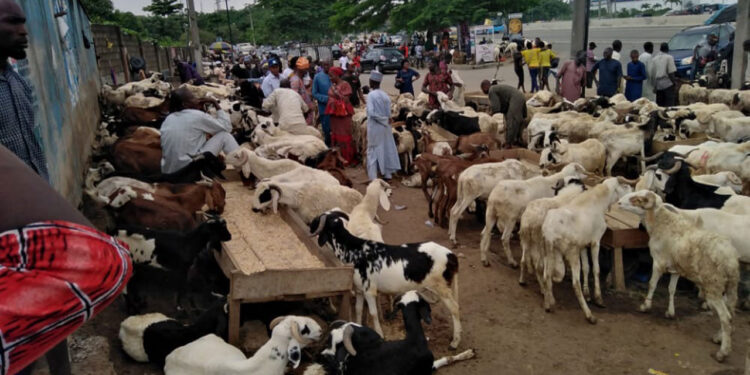Amidst the upcoming Eid-El-Kabir festival, ram sellers in Badagry, Lagos State, are grappling with sluggish sales as costs increase to as much as N750,000 for a large ram.
This is according to a report by the News Agency of Nigeria, showing the current realities of the bellowing economic hardship in the country.
In places such as Alaba, Ajibade, and Agbalata ram markets there are significant variations in the cost of rams, leaving both sellers and buyers frustrated.
In the Alaba ram market, a large ram sells for a hefty price of N750,000, while medium-sized rams range between N350,000 and N400,000.
Smaller rams are priced from N150,000 to N200,000. The situation is slightly different in the Agbalata market, where big rams are sold for N400,000 to N450,000, medium-sized rams for N250,000 to N300,000, and smaller ones for N120,000 to N150,000.
What the ram sellers said
Reports show that in Ajibade ram market in Aradagun, another seller, Belawu Ajadi highlighted the compounded costs of feeding and transporting the rams as factors contributing to high prices.
“Customer turnout is low compared to last year. By this time in 2023, I had sold over 50 rams; this year, I’ve sold just ten,” Ajadi said. Despite the economic downturn, he remains hopeful that sales will pick up as the festival approaches.
The buyers, too, are feeling the pinch. Yusuf Ajadi, shopping at Alaba market, recounted how prices have more than doubled.
“In 2023, I bought two rams for N280,000. Today, a medium-sized ram costs me N400,000, making it unaffordable to buy two,” he said. Another buyer, Alhaji Taoreed Ajape, expressed shock at the inflated prices. “I came from Ikoga, Badagry, expecting better deals. The ram I bought for N100,000 last year now costs N220,000,” he shared, indicating that he might have to return after securing more funds.
Economic strain and buyer hesitation
Alhaji Abdul-Salam Hassan, a ram seller at Alaba market, attributed the steep prices to high transportation costs. “I spent N1.5 million transporting my rams from Sokoto State. I need to recoup these costs to make a profit,” he explained. Despite bringing 300 rams to the market since June 5, Hassan has sold fewer than ten. “Many buyers inquire about prices but fail to return,” he lamented.
Hassan also noted that while last year’s prices were considered high, this year’s have skyrocketed due to the removal of fuel subsidies, which has significantly increased transportation costs.
Context
The situation in Badagry reflects broader economic challenges affecting Nigeria. Nigeria currently battles a cost of living crisis with inflation at a 28-year high of 33.69% and food inflation almost at 34%.
Prices of staple food across the country, especially grains, have seen an almost 100% increase since last year because of disruption in global supply chains due to conflicts in the Middle East and Europe.
In July last year, Russia withdrew from the United Nations Black Sea grain deal that allowed free passage of grains to Sub-Saharan African countries, including Nigeria. Furthermore, the disruption of cargo traffic around the Black Sea by Houthi rebels also contributed to an increase in food prices.
Furthermore, the removal of fuel subsidy by President Tinubu earlier in his administration significantly increased transport prices across the country which contributed in no small measure to the rising food prices.
Also, the depreciation of the naira following the unification of the foreign exchange market in June contributed to the high inflation levels as food imports became more expensive.
The naira has depreciated by over 100% on the official market since the unification of the forex market in 2023.





















